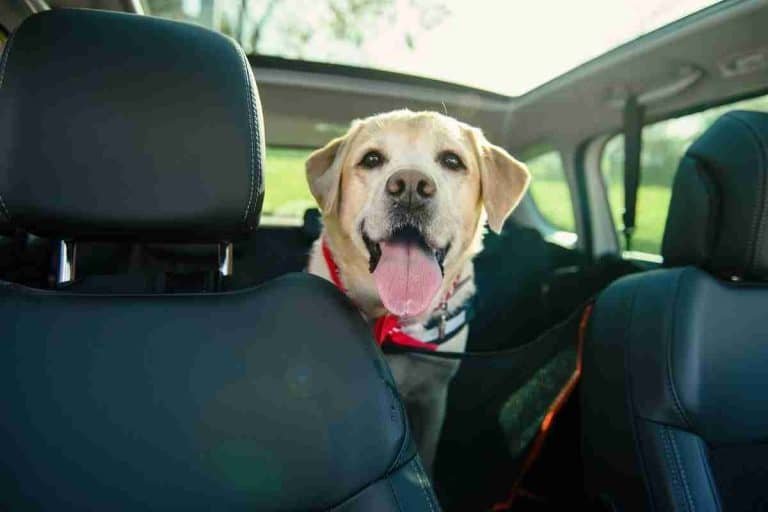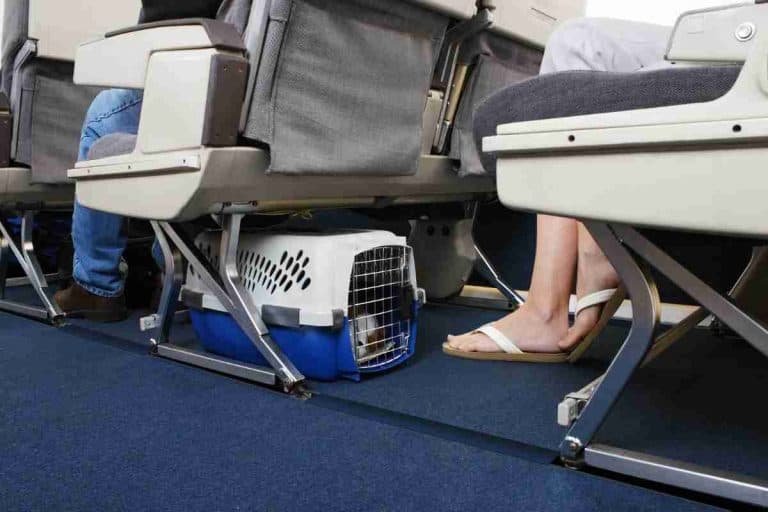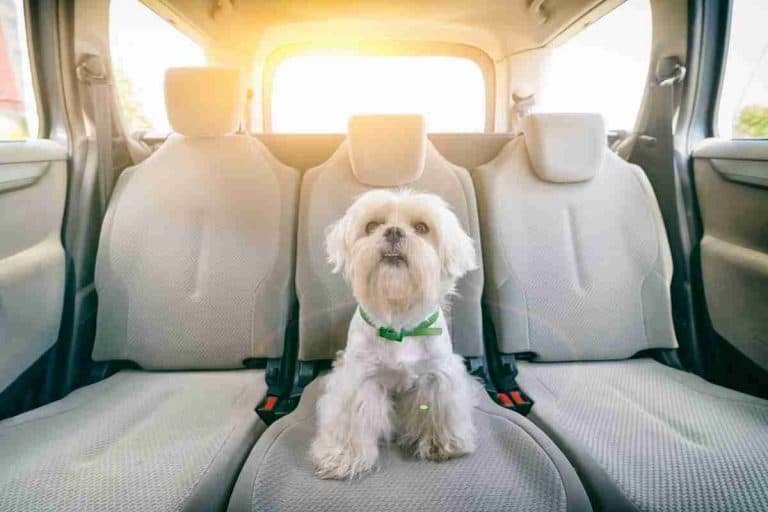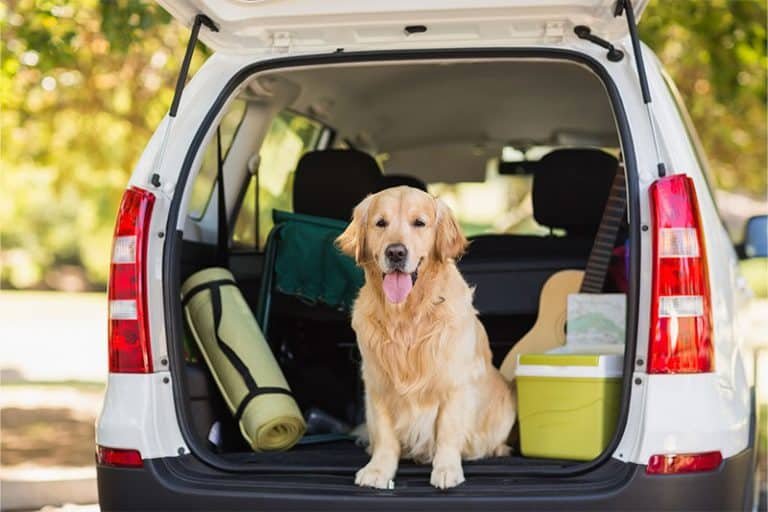9 Tips for Hammock Camping with Your Dog
Affiliate Disclaimer: As an affiliate, we may earn a small commission when you make a purchase from any of the links on this page at no additional cost to you!
Hammock camping is a unique and enjoyable experience. What better way to go on an adventure than with your best buddy?
However, it can prove to be a challenge on your dog’s first hammock camping trip. Things such as their size and temperament play a large role in your camping experience. It may be a frustrating endeavor if you find yourself and your dog unprepared for the nights ahead.
Here we list 9 Tips for Hammock Camping with Your Dog, as well as a list of equipment and a guide for hammock camping with them.
9 Tips for Hammock Camping with Your Dog
1. Make Sure Your Dog is Prepared for Camping
Not all dogs like sleeping in hammocks. This can be due to many things such as their species or personality. You may find larger dogs enjoy hammocks more than smaller ones, however, there are exceptions.
Before going on your camping trip run a mock test at home in your backyard. You may find that your dog enjoys sleeping outdoors but doesn’t like hammocks, or even the other way around. It is best to be prepared and organize a backup sleeping arrangement if it doesn’t work out.
Making sure your dog is trained is also crucial. If your dog isn’t properly trained to listen to your commands, they may end up running off and getting in trouble or hurt. If they don’t get along with other people or animals, this may also be a setback.
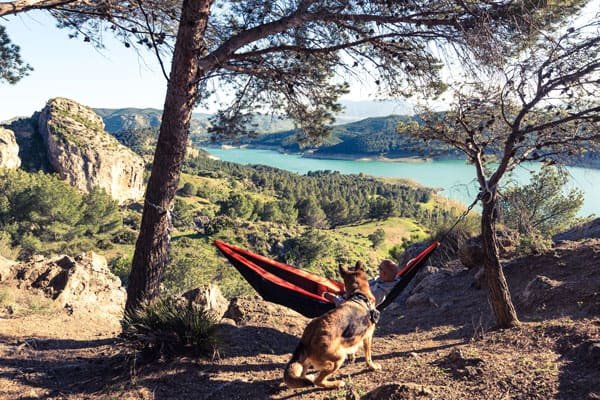
2. Select the Right Campsite
When looking for a place to camp, be sure to check whether or not they are dog friendly. Not all camping sites allow dogs. Remember that dogs aren’t allowed outside of designated camping grounds in national parks, so check the rules regarding the campsite before deciding on a camping spot.
You’ll want to find a place where the ground is safe. You do not want your dog to hop out of the hammock onto sharp stones and get injured. Always set up your camping site away from slopes as that can also be a hazard.
3. Sleeping Arrangements
When choosing a hammock for you and your dog there are several things to take into consideration. Durability, size, and comfort are all things to consider when selecting a hammock for camping.
Also, consider whether or not you are sharing a hammock with your dog. This is easier to do with smaller dogs, however, you may find that you have a larger dog that refuses to sleep without you. Check the size of your hammock to ensure there is enough space for you and your dog.
4. Use Separate Hammocks
If your dog is comfortable sleeping separately from you, you may want to consider a separate hammock for your dog. This is ideal for larger dogs as they will take up a lot of space. You will both probably get a better night’s sleep if you sleep separately.
Set it up in a place where you can keep an eye on them and make sure it’s near enough to the ground that your dog can get out themselves when needed without hurting themselves.
5. Bring a Backup Hammock
Sometimes things go wrong while camping. Your dog may decide last minute it wants a separate hammock, or perhaps one of them breaks or isn’t functioning properly. Bringing a spare can be a lifesaver for both of you.
6. Prepare a Back-Up Plan
Not all dogs like sleeping in hammocks, but that doesn’t mean they can’t tag along on your trip. Prepare a backup sleeping arrangement for your dog outside the hammock.
You can do this by arranging a place beneath your hammock, this will also keep them under the rainfly. Place some tarp on the ground before placing their bed, blankets, or sleeping bag down on top of it to allow for a comfortable sleeping experience.
However, you may find your dog doesn’t like sleeping outside at all. You may have to consider a tent for your dog. If your dog prefers a tent but won’t sleep separately from you, you may have to reconsider hammock camping altogether.
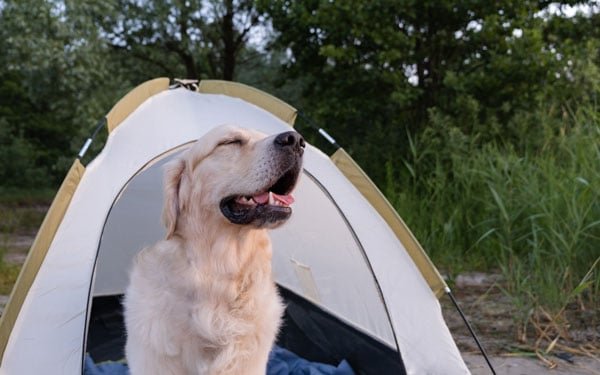
7. Keep Your Dog Secure
When camping, keep your dog on a leash. Dogs are curious animals and may wander off or chase after a noise at night.
Tie them to a nearby tree to ensure that they don’t wander off, especially at night. Or they could end up hurt or lost.
8. Keep Your Dog Comfortable
Comfort is important for the happiness of both you and your dog. They may feel insecure about camping. If so, be sure you are in your dog’s field of vision while you sleep. They may also feel insecure when sleeping in a separate hammock. By being calm and relaxed, you can reassure your dog and help them to relax too.
Bring a blanket to cover your dog to keep them warm inside their hammock. If they choose to sleep on the ground instead, consider purchasing a sleeping bag for your dog to keep them warm.
Some hammocks come with bug nets. This can be useful, especially in the warmer seasons. Purchasing one can help both you and your dog sleep unbothered.
9. Clip Their Nails
Long nails can risk tearing hammocks. Your dog’s nails can also get stuck inside the tears and become a safety hazard for your dog, causing injury. Clip their nails before the trip to prevent accidents and damage to your hammocks.

9 Things to Bring While Hammock Camping with Your Dog
1. Suitable Hammock
When choosing a hammock, find one that is durable and strong enough to withstand any potential damage and weight. When purchasing a hammock, try to find one that allows your dog to lie down as flat as possible.
If your dog prefers to sleep with you, invest in a double hammock to give the two of you enough space to sleep comfortably.
Note that some hammocks do not come with hammock straps and that you will have to purchase them separately. Look for high-grade ones that can support the weight of both you and your dog.
2. Dog Bed
If your dog prefers to sleep on the ground, taking with their dog bed may help them feel comfortable and at home
3. Sleeping Bag
Another option is a sleeping bag. This will keep your dog warm on cold nights and help them feel safe and secure.
4. Tarp
Before placing their bedding or sleeping bag, put a tarp on the ground. This will keep their bedding off the dirt and prevent them from getting wet.

5. Blankets
Regardless of whether your dog sleeps in the hammock or on the ground, you may want to bring along their blanket or quilt to keep them warm on colder nights.
6. Bug Nets
Some hammocks have bug nets built in already, however, if yours does not have a built-in bug net you can purchase them separately. These will help you and your dog have a peaceful night’s rest without being bothered by blood-sucking pests.
7. Collar and Leash
When camping, you want to ensure your dog doesn’t wander off too far, while allowing them to move in and out of the hammock freely as needed. Attach their leash to their collar and tie the other end to a nearby tree to keep them close.
Dog runners are also recommended. They are longer than leashes allowing your dog more space to move. If a tree happens to be too far, it will be long enough to reach the tree without choking your dog.
8. ID Tags
ID tags are essential as they can help to identify your dog in the event that they do manage to wander off. Be sure they are securely attached to their collar before leaving for your trip.
9. First Aid Kit
It is always important to bring a first aid kit. Fill it with any necessary medical supplies both you and your dog may need. Research the locations of nearby vets in case of an emergency.
How to Train Your Dog for Hammock Camping
If your dog has never experienced hammock camping before they may find it daunting and scary. Training your dog using mock tests will help your dog grow confident and comfortable and prepare them for the real thing.
The first step is to introduce your dog to the hammock. Place the hammock on the ground and allow them to smell and lay down on the hammock. Reward them with treats when they do.
Next, try setting it up so that the bottom is just touching the ground. Tell them to hop on and reward them when they do. Remember to be patient and let them take their time, rushing them may make them nervous and it may be impossible to get them to approach it again.
Slowly start lifting the hammock off the ground a little more each time. If your dog is nervous, sit on the hammock and let them lay across your lap until they build enough confidence to sit there on their own.
Finally, take your dog to mock camps in your backyard. This will help them get used to the outdoor all-night experience while being in the comfort of their own home. Once you are confident that your dog is ready you can start planning your first away-from-home camping trip together.

Safety
Never Hang the Hammock Over Uneven Surfaces
Hanging hammocks over uneven or sharp surfaces can be dangerous or even fatal. Your dog may cut their feet or injure themselves by jumping or falling out of the hammock. Avoid any areas with slopes as it can be a hazard for both of you, especially at night.
Make Sure the Hammock is Stable
When setting up your hammock, find strong, stable trees to hold them up to avoid the risk of fallouts. Fallouts can be extremely dangerous for you and your dog. Check that you have tied your hammock securely to avoid any accidents from occurring.
Keep Your Dog Close
When camping it’s always best to keep your dog close and in sight. Dogs are curious creatures and are easily amused or distracted. You may find them chasing after wildlife or noises and risk getting hurt or lost. However, if your dog is well-trained you shouldn’t have a problem keeping them nearby.
Conclusion
Hammock camping can be an enjoyable experience for you and your dog to share. While sleeping in hammocks isn’t for every dog, that doesn’t stop you from taking them along on your adventure. By utilizing the 9 Tips for Hammock Camping with Your Dog you can ensure a fun trip for both of you to experience. Happy camping!


